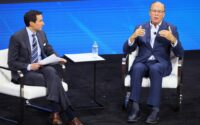Why a US housing recovery is ‘still miles away’ after sales cratered in November
The struggling US housing market is “still miles away” from a recovery, a prominent firm warned Wednesday after data revealed existing home sales cratered in November.
Sales of previously owned homes plunged 35.4% to 4.09 million in November compared to the same month one year earlier, according to a monthly release from the National Association of Realtors. Sales fell 7.7% from October to November.
Existing-home sales have fallen for 10 consecutive months — the longest losing streak on record. The typical property stayed on the market for 24 days last month, up from 18 days year-over-year.
The alarming drop in sales is mostly attributable to the impact of surging mortgage rates, which have resulted in much higher monthly payments for buyers. While the average 30-year rate dipped to 6.31% as of last week, it has still more than doubled since January.
“Our estimate of monthly mortgage payments was still up by 53% year-over-year in November, however, supporting our view that a meaningful recovery in sales is still miles away,” Pantheon Macroeconomics senior US economist Kieran Clancy said in a note. “House prices, meanwhile, have much further to fall from here.”

Home prices are still “extremely elevated by past standards” and are likely to slide by “a further 15 to 20%” over the next year, according to Clancy.
The housing market has been under immense pressure this year as the Federal Reserve hiked interest rates to tame inflation. Higher mortgage rates have scared off potential buyers and caused sellers to either slash their listing prices or think twice about trading in their existing low rate for a new property.
The median existing-home price fell for the fifth straight month, dropping to $370,700 in November after peaking at $413,800 in June. Still, the price was up 3.5% compared to one year ago — a sign that the correction could be just getting started.

“In essence, the residential real estate market was frozen in November, resembling the sales activity seen during the COVID-19 economic lockdowns in 2020,” said NAR chief economist Lawrence Yun.
Fed Chair Jerome Powell has repeatedly acknowledged that policymakers are seeing significant weakness in the housing market due to the impact of interest rate hikes.

In a late November speech, Powell referred to conditions in the market as a “bubble.”
“Coming out of the pandemic, rates were very low, people wanted to buy houses, they wanted to get out of the cities and buy houses in the suburbs because of COVID,” Powell said. “So you really had a housing bubble, you had housing prices going up very unsustainable levels and overheating and that kind of thing.”
“Now the housing market will go through the other side of that and hopefully come out in a better place between supply and demand,” Powell added.


